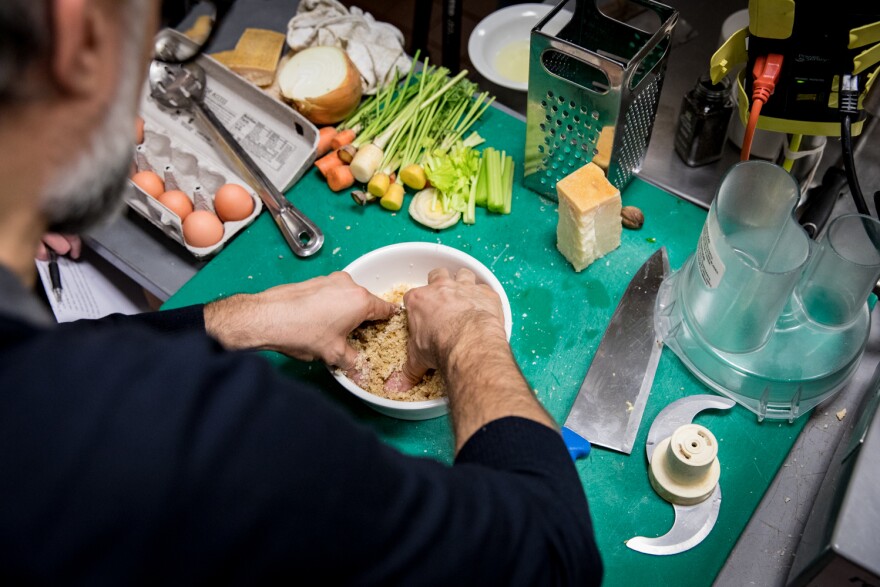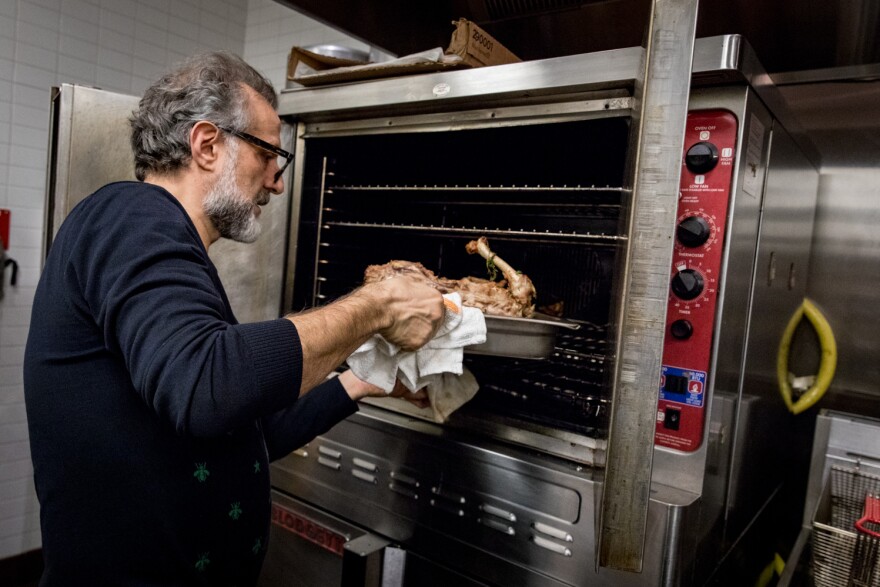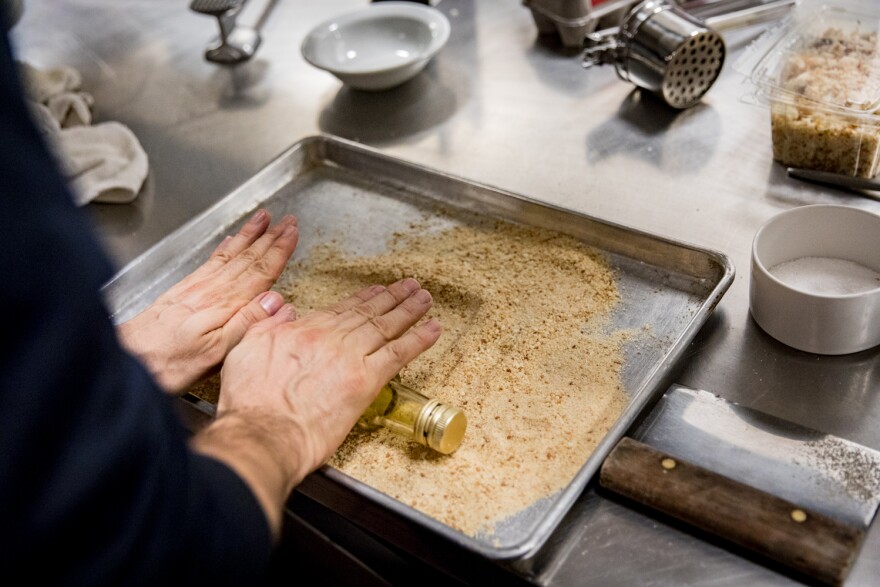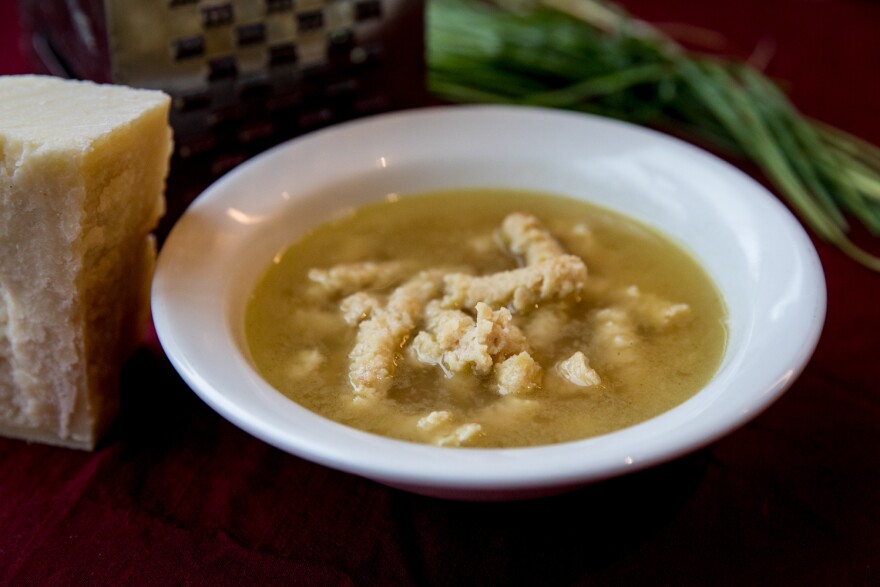Food waste is a huge problem globally — starting with our own refrigerators. Over this Thanksgiving week, Americans will throw out almost 200 million pounds of turkey alone, according to figures from the Natural Resources Defense Council.
But before you toss that bird, read on. We asked Massimo Bottura, one of the world's best chefs, to help us figure out what to do with our holiday leftovers.
Bottura is a rock star in the food world. His restaurant in Modena, Italy, Osteria Francescana, has three Michelin stars. But at this moment, he's in the kitchen of NPR's cafeteria, bent over a compost bin. He's looking for ... ingredients.
"I found something very interesting — onion peels and celery," Bottura says as he straightens up again. He also plucks out the stems of a bunch of Italian parsley and declares them "perfectly fresh."

Bottura is a firm believer that nothing should be wasted in the kitchen. Most Americans aren't so conscientious. A recent NRDC survey in three U.S. cities found that the average American tosses out 2.5 pounds of perfectly edible food each week. At the top of the list: produce and leftovers.
"The leftover is a big problem if you don't have a vision, if you don't have the knowledge of what you can do," Bottura says.
Bottura's vision for our Thanksgiving leftovers is a traditional dish from Emilia-Romagna, the region of northern Italy that he calls home. It's a pasta dish served in broth: "Passatelli!" he says, letting each syllable roll out slowly on his tongue. It's his daughter's favorite dish, he says.
To make passatelli, you'll need a turkey carcass, leftover bread, eggs, Parmigiano-Reggiano cheese and nutmeg. (The full recipe is below). As for the rest? It depends on what you have on hand. Bottura takes the scraps he found in our compost bin — celery, parsley, an onion which he chops roughly, skin and all — and lays them next to the turkey bones on a baking sheet. Then he adds something most of us toss out: the leafy green tops of carrots. He breaks off some of the greens and dips it in olive oil for me to taste: It's very flavorful.
"People don't realize how many ingredients you can discover if you are curious," Bottura says.

The turkey bones and vegetables go in the oven to roast for about 45 minutes at 350 degrees Fahrenheit, though we check on the bones often to make sure they don't burn. (Roasting coaxes more rich flavor out of the bones.) When improvising in the kitchen, Bottura says, it's important to use your nose as a guide. When the aromatic scents from the oven smell just like Thanksgiving dinner, we know the bones are ready to make broth.
We cover the bones in a big pot with water, add more veggie scraps and a Parmigiano-Reggiano cheese rind that Bottura found in the NPR fridge. (He says it called out to him: "Use me! Use me! Touch my soul!") The rind, he says, will be important to creating a savory broth.
While the broth heats, we turn to breadcrumbs — a good way to use up those stale rolls from Thanksgiving. If the bread isn't dry enough, you can toast it in the oven first for about 20 minutes at 250 degrees. Then, grind up the bread in a food processor.
Or do what Bottura did to get an even finer texture: roll over the crumbs with a glass bottle, a trick he learned from his grandmother.

"If my grandmother could see me doing this now in Washington, she would laugh," he says as he works.
The breadcrumbs go into a bowl with eggs, some grated Parmesan and nutmeg.
Bottura kneads it all into dough, then squeezes it through a ricer to make thick noodles. (You can also roll the dough by hand into gnocchi-like shapes.) By now, our broth has been simmering for about 40 minutes and is full of flavor, so we plop in the noodles and raise the heat to high. Once it reaches a boil, the pasta is ready.
The result is delicious, warm, hearty — perfect for a cold day.
"Food costs? Nothing. Emotion? A lot," Bottura says as we savor his handiwork.

The cost of not eating our leftovers, on the other hand, is big — for our wallets and for the planet.
"The average household of four is wasting about $1,800 annually on food that they buy and then never wind up eating," says Dana Gunders, senior scientist at NRDC, citing the group's latest figures.
"Households are actually the biggest contributor to the amount of food going to waste across the country — more than grocery stores or restaurants or any other sector," Gunders says. Food is the No. 1 contributor to landfills, and as it decomposes, it releases methane, a powerful greenhouse gas.
But Gunders says changing our habits at home really can make a difference. That means things like planning before shopping so we don't buy more food than we can use in a week, freezing food before it goes bad — and learning to love leftovers.
For Bottura, changing the culture around wasting food has become a passion. His new cookbook, Bread Is Gold: Extraordinary Meals with Ordinary Ingredients, is full of recipes and tips for home chefs to improvise with whatever is in the fridge. His goal is to create more confidence in home kitchens. "This is not a charity project," he says. "It's a cultural project."
"You're going to spend less, you're going to have better food, you're going to save money and fight waste," he says. "Because it's about you, your creativity." All proceeds from the book go to Food for Soul, Bottura's nonprofit that is setting up soup kitchens stocked with surplus flood in cities around the world.
"This is a mission," Bottura says. "You know, cooking is an act of love. And so if you can transfer that to people, you can change the world."
Changing the world ... one leftover meal at a time.
Massimo Bottura's Passatelli in Turkey Broth
Editor's note: This is the recipe Bottura improvised in NPR's kitchen. It's based on a recipe handed down from his grandmother, which we've also included below.
For Passatelli:
10 ounces dried breadcrumbs
¾ cup plus 2 tablespoons freshly grated Parmigiano-Reggiano cheese
3 eggs
¼ teaspoon salt
½ teaspoon ground pepper (either black or white is fine)
Grated nutmeg to taste**
To make the breadcrumbs, you can run stale bread through a food processor. Make sure the breadcrumbs are dry — you'll want them to be almost powdery when ground up. If your crumbs aren't dry, toast them in the oven at 250 degrees Fahrenheit for about 20 minutes (but don't let them burn).
In a medium bowl, mix together the breadcrumbs, Parmigiano and nutmeg. Mix in the salt, pepper and eggs. Bottura's advice: Start by adding one egg at a time so that you don't end up with dough that's too watery. Bottura started by adding 1 whole egg plus one yolk (because he loves the taste), then added another egg after finding the dough was still too dry. You don't want dough to be too mushy or too dry — just wet enough that it holds together.
Gather the dough into a ball, cover with plastic wrap and set it aside for 20 minutes. When it's done resting, push the dough through a ricer and drop the noodles into the turkey broth (once it is ready). (Note: If you don't have a ricer, you can roll the dough by hand instead but may need to use more eggs to create a more malleable dough.)
For turkey broth:
Turkey bones
Onions
Carrots
Parsley
Celery
Parmigiano-Reggiano rind
Lay the turkey bones out on a baking sheet or pan with an edge. Add the onions, chopped roughly, skin and all, green carrot tops, parsley. (The vegetables enhance the flavor of the bones.) Roast in the oven at 350 degrees Fahrenheit for about 45 minutes, checking the bones every 10 minutes or so to make sure they don't burn, as that will alter the flavor of the broth. After about 20 minutes, use tongs to turn over the bones to ensure even roasting.
When roasted, put the bones in a pot and cover them with cold water. Add fresh onions (no peels this time), more carrots and celery (not the vegetables you just roasted). Bottura added the Parmigiano-Reggiano rind he found in the NPR fridge for added flavor.
Let the broth simmer on medium-low heat for at least 40 minutes (an hour or more is ideal). Once it tastes right (nice and meaty), drop the passatelli into the broth and raise the heat to high. When the passatelli surfaces (about 1 minute), it's ready. (Over-boiling will result in mushy pasta.)
Serve passatelli in broth, topped with Parmesan cheese.
Nonna Ancella's Passatelli
Courtesy of Massimo Bottura and his wife, Lara Gilmore
Breadcrumbs are the epitome of the "waste not, want not" food ethic. If there is an important lesson we have learned from the Italian kitchen, and one that we can pass on to future generations: Never let edible food go to waste! We share this message in the shape of my grandmother Ancella's recipe for passatelli in broth.
This classic Emilian recipe, passatelli in broth, has been passed on from generation to generation in the Bottura family. Our daughter, Alexa, learned to make passatelli from her grandmother Luisa. Massimo learned how to make them from his grandmother Ancella. It is a rite of passage in many Modenese households. The recipe is so easy and child-friendly, we encourage teaching the whole family to get their hands messy and cook with their parents.
For the broth, a classic vegetable or chicken broth is best. However, in an emergency, Massimo often prepares a Parmigiano-Reggiano rind broth. He keeps all the rinds from grated cheese in the refrigerator until he has a good amount — say ½ pound. The cheese rinds can be added to a big pot of cold water and simmered for a couple of hours. As the rinds melt, they give off flavor and thicken the broth with the proteins and fats from the cheese. This broth is very simple but can be great to have in a pinch. Of course, the cheese rinds can also be added to classical broths to enrich the flavor as well.
Ingredients:
1 ½ cup (150 grams) breadcrumbs
1 cup (100 grams) grated Parmigiano-Reggiano
3 eggs
pinch of ground nutmeg
34 ounces (1 liter) of chicken broth
1 teaspoon of lemon zest
Kitchen tools:
potato ricer with large holes
large pot for broth
ladle
Place the breadcrumbs, Parmigiano-Reggiano, nutmeg and lemon zest in a shallow bowl. In the meantime, bring broth to a low simmer. Break the eggs and add to the dry ingredients. Mix together into a uniform ball of dough. Place the dough in a ricer and press it directly into the boiling broth. Cook the passatelli until they surface, about 1 minute. Serve hot with broth in a bowl.
Copyright 2023 NPR. To see more, visit https://www.npr.org.








